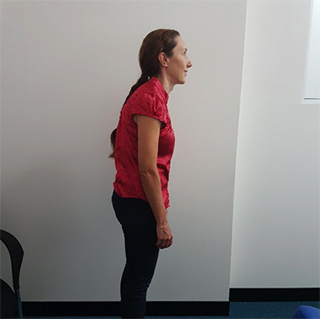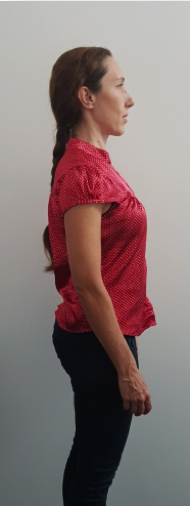Overtime, certain imbalances will spread out throughout the muscular system in a certain manner. These predictable systems are referred to as upper and lower crossed syndrome. Both the upper and lower crossed syndromes vary in what muscles are inhibited and which ones are facilitated. The muscles surrounding these areas are often referred to as being weakened or tightened.
Upper crossed syndrome:
- Facilitation/tightness of the upper trapezius, levator scapula, sternocleidomastoid and pectoralis muscles (muscles in the front of the neck)
- Inhibition/ weakness of deep cervical flexors ( muscles at the back of the neck ), lower trapezius and serratus anterior
Lower crossed syndrome:
- Facilitation/tightness of the thoraco-lumbar extensors, rectus femoris and iliopsoas
- Inhibition/weakness abdominals (particularly the transverse abdominus) and the gluteal muscles

Classifying the patient can help clinicians predict certain patterns of tightness and weakness in the sensorimotor system’s attempt to maintain homeostasis. Muscular tone changes have led to muscular changes resulting in movement dysfunction. The muscles most commonly prone to tightness generally have a low irritability threshold and are readily activated creating abnormal movement patterns and poor posture. The movement dysfunctions and joint changes that the conditions create lead to joint degeneration. Commonly many disorders occur secondary to joint/muscular imbalances so it is important for clinicians to treat the cause of the pain instead of focussing on the source of the pain.
Treatment of Jandas upper and lower crossed syndrome consists of chiropractic care, physical therapy and exercises. Chiropractic care firstly works on relieving the overactive/tightened muscles using soft tissue techniques including, massage, thumper, instrument assisted soft tissue therapy, dry needling, stretch and trigger point therapy and then incorporates adjustment over the cervical, thoracic and lumbar regions to realign joints out of place.
 Once manipulated/adjusted and the hypertonic (tight) muscles are resolved, the next step involves strengthening exercises to build up the muscle strength around the joints to prevent the reoccurrence of the poor posture. These exercises can involve chin tucks, scapular retraction, wall angles, bird dog and other core stabilisation exercises. Postural taping is also prescribed in treatment to make sure that patients aren’t returning to old habits and hunching their shoulders forward. The tape reinforces the idea of pinning the shoulders back to prevent tightness of the muscles mentioned above.
Once manipulated/adjusted and the hypertonic (tight) muscles are resolved, the next step involves strengthening exercises to build up the muscle strength around the joints to prevent the reoccurrence of the poor posture. These exercises can involve chin tucks, scapular retraction, wall angles, bird dog and other core stabilisation exercises. Postural taping is also prescribed in treatment to make sure that patients aren’t returning to old habits and hunching their shoulders forward. The tape reinforces the idea of pinning the shoulders back to prevent tightness of the muscles mentioned above.
So if you have back or neck pain that has been bothering you for some time, or you’ve noticed the musculature around these areas feel very tight or weak and have caused you to hunch forward and have poor posture, Lakeside Chiropractic may assist you. Lakeside Chiropractic is central to Perth’s northern suburbs including Kingsley, Heathridge, Jindalee, Leederville, Mullaloo, Padbury and Hilary’s and is located in the centre of Joondalup on 3/45 Central Walk.
We have a HICAPS terminal on site which means you can claim direct from your health fund on the day of your treatment. We are a Medibank and BUPA preferred provider but we are also able to process claims from HBF, HIF, CU Health, health.com.au, ahm, Defence and Australian Unity Health. If your fund is not listed, please feel free to ask one of our friendly staff members. Here at Lakeside Chiropractic our staff are fully trained and regularly see visitors who they are able to successfully treat and improve posture. Please call us on 9300 0095 or on the website www.lakesidechiro.com.au via the Book Online Now tab.



